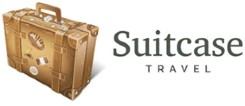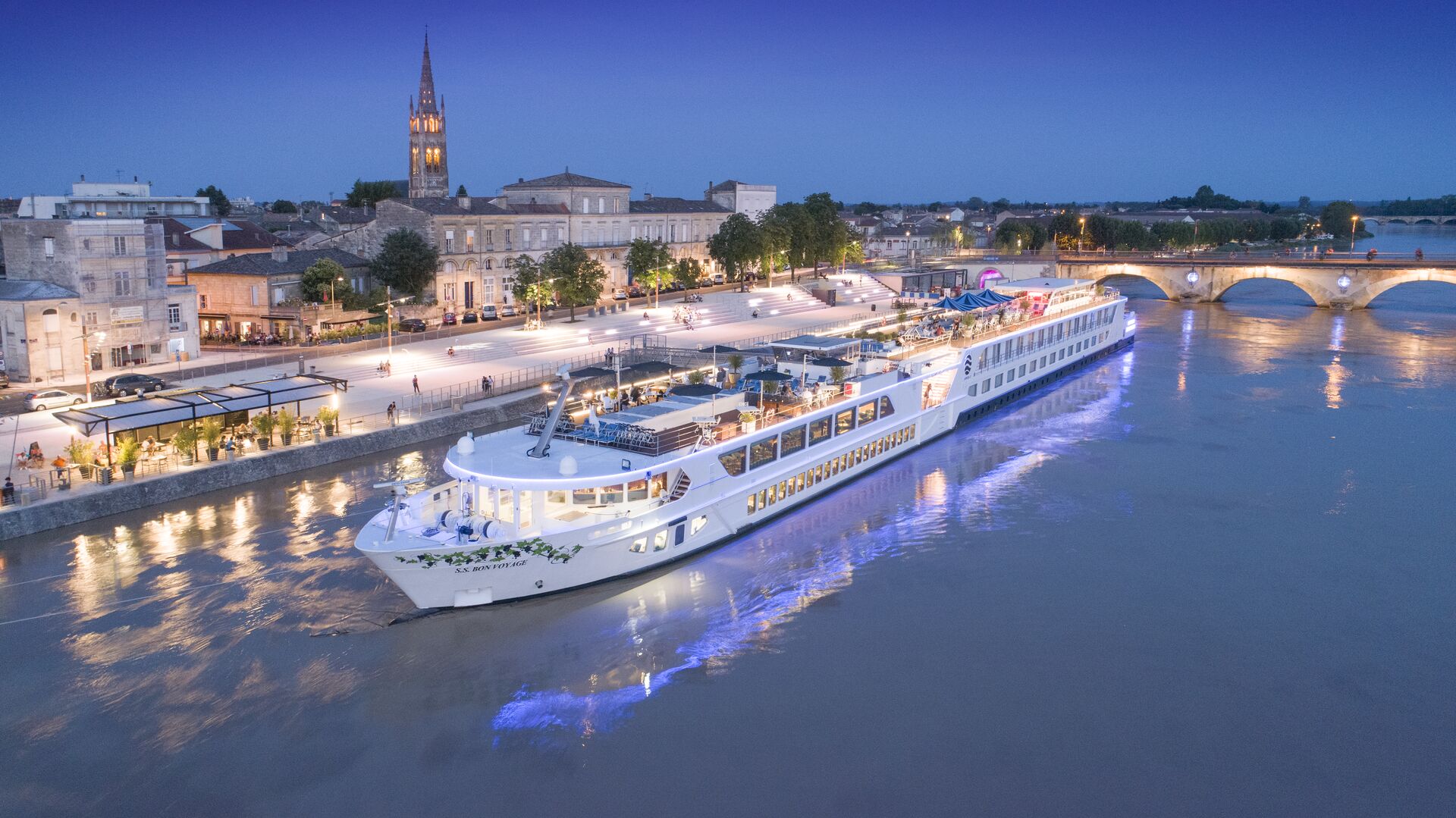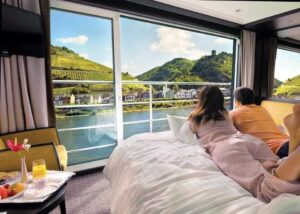Considering your first European river cruise?
Do you have absolutely no idea where to start?
Are you wondering if river cruising is even for you?
You’re in the perfect place!
My aim here is to unravel the mysteries of river cruising and provide answers to all your questions (and don’t hesitate to reach out directly if you have more – my contact information is right at the top of the page!)
Let me introduce myself. I’m Mike Silford, MD of Suitcase Travel and I’ve spent years guiding travellers, just like you, in finding their perfect river cruise.
However, my expertise extends beyond just guiding others.
My wife, Lyn, and I are both avid river cruisers and have experienced numerous journeys across different cruise lines.
River cruising is more than just a hobby for us – it’s a passion. We’ve created countless happy memories while exploring Europe’s enchanting waterways.
The world of river cruising, with its multitude of operators, similar-sounding routes, and amenities, can be bewildering. The ships themselves often seem indistinguishable at first glance.
I do have my personal preferences – including a favourite river cruise line – but you can count on me for balanced and fair insights into the river cruising experience.
This guide is structured around three fundamental questions:
- Is river cruising for you?
- Which European rivers are most suited for first-time cruisers?
- How do you choose the right cruise line for your needs?
So, let’s embark on this journey together and explore the first question…
Is river cruising for you?
What is river cruising like?
Imagine gliding along some of the most picturesque countryside and valleys, courtesy of Europe’s most famous rivers.
Then picture yourself moored in a vibrant city, enjoying views that rival those of the finest 5 or 6-star hotels.
This is the essence of river cruising – a floating hotel that offers a new destination and a fresh experience every day.
The carefully crafted itineraries are designed to traverse the less scenic stretches of the river under the cover of night.
This means that each day, you’re waking up to explore, visit, and sail through the most scenic parts of the river.
The beauty of river cruising is how the ship often docks right in the heart of your destination. It’s like staying in a centrally located hotel, giving you the freedom to explore on your own terms.
As for the onboard experience, expect dining that rivals the best hotel restaurants, with a focus on local cuisine and wines sourced from the regions you’re traversing.
Evening entertainment on a river cruise is a more intimate affair. Most nights feature local musicians, creating an ambiance that blends seamlessly with the gentle flow of the river.
As the week progresses, these cosy evenings often turn into lively gatherings, with new friends dancing to piano tunes in a warm, intimate setting.
River cruising appeals to a variety of tastes and preferences:
- Ideal for those who value comfort, relaxation, and luxury.
- Perfect for visiting multiple destinations with the convenience of unpacking once.
- A haven for lovers of history, culture, gastronomy, and fine wines.
- Great for those who enjoy city breaks with a mix of exploration and relaxation.
While the emphasis on river cruising is often on the onshore excursions, providing a seemingly active and full itinerary, the reality is one of balance.
Your ship docks right at the heart of your destination, offering a plethora of activities and sights, yet always allowing you the time to relax and enjoy at your own pace.
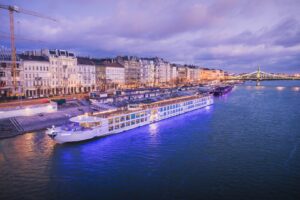
How does river cruising differ from ocean cruising?
At first glance, the differences between river and ocean cruising might not be immediately apparent. After all, both involve majestic ships navigating vast waters, bringing you to new and exciting destinations. But delve a little deeper, and the distinctions become clear.
Here at Suitcase Travel, we like to think of it this way – ocean ships are akin to floating resorts, serving as the primary focus of your holiday.
River cruises, on the other hand, are more like floating hotels, offering a serene and luxurious way to journey between destinations.
One of the most notable differences lies in the logistics of docking. Ocean cruisers typically anchor at major ports, often requiring transfers to reach your sightseeing spots. These larger ships, carrying thousands of passengers, can make the disembarking process somewhat time-consuming.
River cruises, with an average of just 150 passengers, offer a more intimate experience. They dock right in the heart of cities or towns, with all sites conveniently at your doorstep. It’s as hassle-free as stepping out of a hotel — you come and go as you please (at least, when in dock!)
Entertainment varies significantly between the two as well.
Ocean cruising is known for its larger-than-life onboard entertainment, think Broadway-style shows and bustling casinos.
River cruising, however, tends to offer a more low-key entertainment experience. This is because river cruising is as much about the onshore experiences as it is about being on board. It’s more about soaking in the local culture and ambiance than dazzling shows.

So, who is river cruising for? It’s ideal for those who relish being on land, exploring new places, and embarking on fresh adventures.
It’s for travellers who enjoy the journey as much as the destination, appreciating the changing landscapes and the cultural nuances of each stop.
What sort of people will you be cruising with?
The demographic has been getting younger in recent years, with the average age now ranging from the 50s to 70s. Of course, this can vary based on the cruise line, the specific itinerary, and even the season in which you travel.
River cruise passengers are typically well-travelled individuals with a keen interest in history, culture, and a more leisurely pace of exploration.
Thanks to the smaller size of river cruise ships compared to their ocean-going counterparts, there’s a more intimate and social atmosphere on board. This setting naturally fosters interactions among passengers during shore excursions, meals, and other onboard activities.
You’ll find that mingling with your fellow cruisers happens effortlessly, adding a rich social dimension to your travel experience.

What is dress code on a river cruise?
The good news is that river cruising is less about strict dress codes and more about comfort and practicality. Unlike ocean cruises, where you might encounter a variety of dress codes, river cruises keep it simple.
During the day, the emphasis is on casual and comfortable attire, perfect for exploring or relaxing onboard.
Evenings, however, typically call for smart casual dress. While there are no formal nights on a river cruise, some guests do enjoy dressing up a bit for special occasions like the Captain’s Welcome Dinner or the Farewell Gala.
But don’t worry, it’s nothing as formal as a black-tie affair. A dress shirt and jacket for gentlemen, and a cocktail dress or blouse with trousers for ladies, are as dressy as it gets.
Why are river cruises so expensive?
I’m often asked about the cost of river cruising. Let’s tackle this elephant in the room head-on.
River cruising isn’t a budget option, but its value shines when you factor in everything it includes. It’s not just about the expense – it’s about the luxury and experience you receive in return.
Compared to top-tier holidays in the Caribbean or elite Mediterranean hotels, river cruising stands out as a more value-laden choice, often at a lower cost. This is all-inclusive luxury, combining enriching journeys with top-notch amenities and services.
When contrasted with the advertised low prices of ocean cruising, river cruising’s value becomes even more evident, especially when compared with high-end 5- or 6-star ocean cruises. River cruising offers an intimate and culturally rich experience, complete with fine dining, local excursions, and personal touches that larger cruises can’t match.
In essence, river cruising is a luxury holiday that offers exceptional value for the price, providing a unique and comprehensive travel experience that’s hard to find elsewhere.
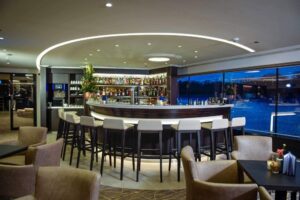
Are river cruises suitable for solo travellers?
Absolutely, yes! River cruises are actually an ideal setting for solo travellers.
With smaller ships and fewer passengers, the environment is naturally more intimate and conducive to socializing. Engaging in the same excursions and sharing meals in close-knit dining settings makes it easy to strike up conversations and form new friendships.
Additionally, the crew and the cruise team onboard are always eager to help you feel included and comfortable. They are excellent at fostering a welcoming atmosphere where everyone feels part of the group.
For those looking to save, keep an eye out for special offers from cruise companies that waive single cabin supplements. These deals can make your solo adventure even more attractive financially.
Furthermore, we work with group tour companies that include river cruising in their offerings. While these companies sometimes feature cruises on older ships, they’re still a great option.
I’m here to help you navigate through the options and understand what to expect. Remember, booking a group tour company holiday through us costs you nothing extra – you pay the same price but also benefit from our unbiased advice and support.
Which European river should I cruise first?
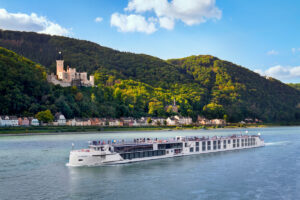
Hopefully, now you know whether a river cruise is for you, and whether you think the prices are justified (or not!) So it’s time to move on to your next decision – which river to start with.
What is the best European river for first time cruisers?
When it comes to selecting the perfect river for your inaugural cruising adventure, Europe is a treasure trove with its iconic rivers like the Rhine, Danube, Seine, Rhone, and Douro, not to mention the Bordeaux region and even the Rhine’s charming tributaries such as the Moselle.
For those dipping their toes into river cruising for the first time, I often recommend starting with the Danube or the Rhine.
Why?
These rivers offer the longest point-to-point itineraries, providing a diverse array of stops and sights without the need for backtracking. This means more exploration, more discoveries, and, simply put, more to see.
However, if you’re a wine enthusiast, then tailoring your choice to your passion is key.
Consider the Bordeaux region, with its myriad chateaus, or the Rhone, both rivers a must for any wine lover. Or the Douro and the highlight of visiting Spain’s University city, Salamanca.
Your interests should guide your choice — after all, the best cruise is one that resonates with what fascinates you the most.
Each river has its unique allure. The Rhine, for instance, offers varied experiences depending on the stops included in your itinerary. It’s crucial not to assume that a cruise on the Rhine with one cruise line will mirror the experience offered by another. Each journey has its own character and highlights.
Speaking of highlights, there are a couple of must-see stops I always recommend on the Rhine.
First, the Gutenberg Museum in Mainz, home to the world’s first printing press and the Gutenberg Bible. With only 48 of these incredible books surviving, each valued at around $6 million, it’s a stop that history buffs and book lovers alike will cherish.
Then there’s the Speyer Technical Museum. This is a hidden gem, boasting an expansive collection of boats, planes, spacecraft, trains, and cars.
I’m always surprised that this museum isn’t as widely talked about as Europe’s other top attractions. It’s a marvel that’s well worth your time.

Are river cruises choppy?
Rest assured, river cruising is characterized by its smooth and tranquil sailing. Unlike the often choppy seas, rivers offer a calm experience with minimal, if any, motion sickness.
Despite being smaller than ocean liners, river cruise ships are designed for stability and glide effortlessly through the water. They’re much larger than typical river vessels, ensuring a steady journey with hardly any turbulence.
So, you can expect a peaceful cruise, free from the worries of seasickness that’s sometimes associated with sea travel.
How to choose the best river cruise line for you
Now that you’re closing in on your ideal river, the next step is to choose the right cruise line. This decision can seem daunting given the plethora of options in European river cruise ships, all appearing quite similar at first glance.
So, how do you discern the differences and select the cruise line that’s best for you?
The key lies in thorough research, particularly in understanding what’s included in the price and what elements align with your vision of a perfect river cruise.
To assist you in this exploration, here are some guiding questions to consider.
What is included on a river cruise?
When planning your river cruise, it’s important to remember that it should encompass everything – full board with drinks, excursions, and entertainment.
From experience, I’ve enjoyed weeks where everything was covered, and the only additional expense was airport refreshments!
However, it’s crucial to be aware of the variations in inclusions among different cruise lines. These differences can significantly impact the real cost comparison between companies.
Don’t be swayed by just the lowest price or the most renowned brand name; what is included in one cruise line’s package might be an extra cost in another.
Remember, this is a luxury holiday with a luxury price tag, and you deserve to get the full luxury experience that aligns with what you’re paying for.
Always scrutinize what’s included to ensure you’re getting the value and luxury you expect from your river cruise investment.
What is the dining like?
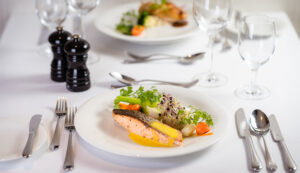
Mealtimes are where river cruising truly shines.
Expect fine dining with meals crafted by talented, professional chefs, an essential part of the river cruise experience.
Mornings usually start with a buffet breakfast offering a variety of hot and cold dishes.
Lunch is a leisurely buffet-style affair, followed by afternoon tea with a delightful sweet treat.
Dinner is a four-course culinary journey, and for those late-night cravings, midnight snacks are available.
Evening dining on river cruises is a relaxed and informal event, featuring free seating.
This arrangement allows you to change your dining spot each night, giving you the opportunity to mingle with different passengers you might have met on excursions or while lounging earlier in the day.
Most river cruise ships have one main dining area, the gastronomic heart of your floating hotel.
The smaller passenger numbers mean everyone dines simultaneously, ensuring a relaxed atmosphere without the rush of multiple sittings.
Some ships also feature a secondary, smaller restaurant for speciality or tasting menus, usually included in your cruise. Suitcase Travel can guide you on which operators and ships offer these exclusive dining experiences.
The quality of food is generally excellent across most river cruise companies, but higher star ratings often mean superior food quality and a more exquisite selection of wines.
For example, top river cruise brands often serve single estate wines, specifically selected to pair with your meal and reflective of the regions you’re sailing through. More mainstream river cruise lines will serve excellent branded blended wines.
If you’re particularly enthusiastic about food and wine, it’s worth considering which cruise line aligns best with your culinary preferences.
Are excursions always included?

Ideally, yes, because excursions are a fundamental part of the river cruising experience.
However, this can vary depending on the cruise line. For instance, with companies like CroisiEurope and TUI, excursions are often optional extras.
While some lines include a few basic excursions, typically walking tours, they may charge extra for more immersive experiences.
For those cruise lines that do include excursions, it’s important to delve into the specifics.
What kind of excursions are offered? Are they limited to basic city walking tours, or do they provide a more immersive experience?
Also, inquire whether you have a choice of excursions at each stop as part of the package, or if these are considered optional extras.
Knowing the details of excursion inclusions can significantly influence your overall river cruise experience, so it’s a key factor to consider when selecting your cruise line.
How Many Passengers are On Board?
Earlier, we touched on the fact that the ships across different cruise lines are generally similar in size.
This is not by chance; it’s a necessity. All ships must fit within the dimensions of the locks and under the bridges they navigate.
This uniformity in size brings us to an important consideration when selecting a cruise line – the number of passengers on board.
On these similarly sized vessels, passenger numbers typically range from 130 to 200.
With 200 passengers, space becomes a premium. Often, this results in smaller cabin sizes and more crowded deck areas.
For example, Viking River Cruises, a brand frequently advertised in the UK, averages around 190 passengers. A glance at the top deck as a Viking ship sets sail reveals the contrast – it’s bustling with nearly 200 passengers, compared to the more spacious decks of ships carrying only 130-150 passengers.
Now, I’m not suggesting you should rule out a cruise with Viking or any other line based on passenger numbers alone. Often, the itinerary itself is the primary draw.
The key is to align your expectations with the reality of your chosen cruise line. Every cruise line we represent guarantees a wonderful experience, but understanding these nuances can enhance your overall satisfaction.
This is where consulting with an independent travel company specialising in river cruising, like Suitcase Travel, becomes invaluable. Our expertise and first-hand experiences with various river cruise lines are unbiased, ensuring you make the best choice for your unique preferences and expectations.
What other nationalities will I be cruising with?
The nationality mix on board can vary significantly depending on the cruise line.
Some lines attract a diverse European clientele, resulting in announcements being made in several languages. This can add a rich, international flavour to your journey.
However, at Suitcase Travel, we primarily focus on promoting cruise lines that cater to English-speaking guests.
We’ve found that, especially for first-time river cruisers, being among predominantly English-speaking passengers – be they from the United States, Canada, Australia, New Zealand, or the UK – makes for a more familiar and enjoyable experience.
Of course, the choice is yours, and part of the adventure is in the diversity of people you meet.
If you’re wondering about the typical passenger mix on different river cruise lines, Suitcase Travel is here to help. We can provide detailed insights into the passenger demographics of each line, ensuring you find a cruise that suits your social and language preferences.
Is it worth getting a balcony on a River Cruise?
In most cases, the answer is no. Let me explain why.
Given the need for river cruise ships to fit into locks and under bridges, their sizes are quite uniform. This size constraint means adding a full balcony would encroach on your cabin space, resulting in a smaller room.
A more practical option is a Juliette balcony. These feature floor-to-ceiling windows that either slide open or lower halfway, offering the ambiance of a balcony without sacrificing cabin space. Some cruise lines offer double sized cabins, a notch down from a full suite, that have both a Juliette and full balcony, leaving you plenty of space within the cabin.
The base price for most river cruises usually corresponds to lower deck cabins. These cabins, closer to the water, often have smaller, sealed windows but are just as comfortable as those on higher decks, with the same amenities.
Considering how little time you actually spend in your cabin – busy with day excursions, basking in the sunshine on the top deck, or dining in the ship’s restaurants – these lower deck cabins can be a great choice, especially for budget-conscious travellers or those, like me, who prefer to indulge in more than one cruise a year!
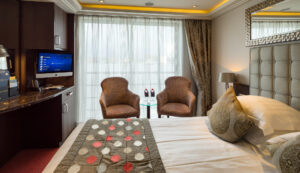
example of a cabin with Juliette balcony (AmaWaterways)
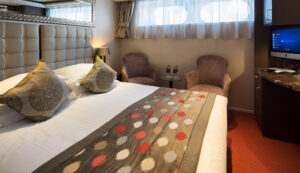
example of lower (river level) deck cabin (AmaWaterways)
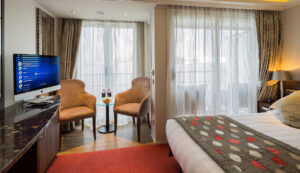
example of double cabin (Juliette and full Balcony) with AmaWaterways – you can see how much space a full balcony takes away from cabin when you see Juliette and balcony side by side.
Which cabins should you avoid on a river cruise?
When it comes to choosing cabins on a river cruise, it often boils down to location rather than the cabins themselves, as preferences can vary greatly among travellers.
However, there’s a piece of advice I often share based on both personal experience and feedback from fellow passengers – consider avoiding cabins at the rear of the ship on all decks.
The reason? Engine noise. While it’s never been a problem for me, I’ve heard from many light sleepers that it can be somewhat bothersome.
Another little tip- choosing a cabin closer to the restaurant and lounge can be quite convenient.
River cruise ships aren’t massive, but it’s always nice to have a shorter stroll back to your cabin after enjoying a delicious meal or a relaxing evening. 😊
As for lower deck cabins, you’ll usually find them more toward the front of the ship, as the rear cabins are typically reserved for staff. This positioning can offer a quieter experience and is worth considering, especially if you’re sensitive to noise.
How should I book my River Cruise?
Here’s why I think booking with me at Suitcase Travel is your best move:
- Expertise from Experience – at Suitcase Travel, we’ve personally journeyed with various cruise companies and experienced river cruising firsthand. This means we can offer you tailored advice to find the cruise and river that perfectly aligns with your travel dreams.
- Unbiased Guidance – we’re not tied to any specific cruise company, but are agents for most, so our advice is always unbiased and centred around what’s best for you, not us.
- Navigating Cabin Choices – selecting the right cabin for your needs and budget can be tricky, but I’m here to guide you through the process, ensuring you get the best fit.
- Flexible Travel Arrangements – our service extends beyond just the cruise. We can help you with flight arrangements and organize pre and post-cruise land stays, all tailored to your preferences.
- Cost-Effective – booking with us won’t cost you extra. In fact, our flexibility in travel arrangements can sometimes even save you money.
- Access to the Latest Offers – we stay updated with the latest deals and offers, saving you the hassle of searching through countless websites. As a leading River Cruise agent we receive offers that are not advertised directly to the public – it always worth giving me a call!
And here are some extra benefits of booking with Suitcase Travel:
- Price Match Guarantee – find the same trip cheaper elsewhere? I’ll match the price, ensuring you get the best value for your experience.
- Financial Security – as an independent family business aligned with the Hays Travel Group, we offer 100% financial protection, giving you peace of mind and the best deals on the market.
- We’ve Got Your Back- should anything go awry with your trip, we’re here to support you, backed by the resources of Hays Travel.
Ready to start planning your river cruise?
Contact me to talk about your river cruise on 01582 349480 or email directly at [email protected]
Let’s make your river cruise dream a reality!
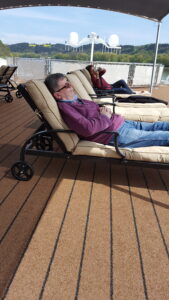
Mike proving you can relax on a river cruise – fast asleep on Ms Maria Theresa!
